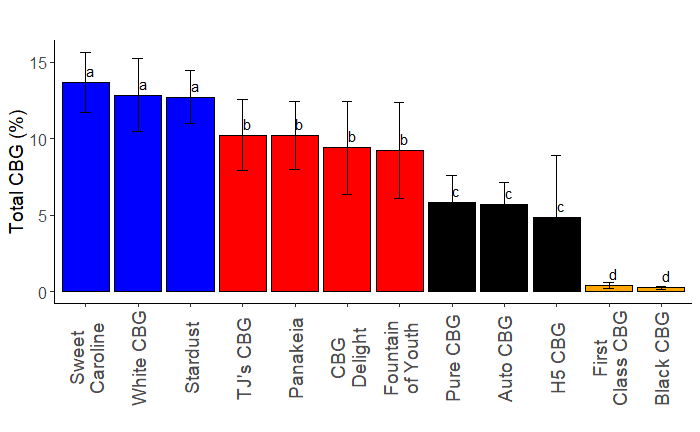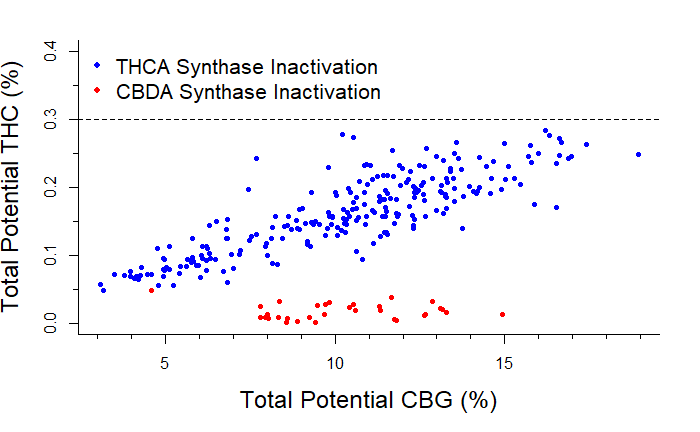Click here for a printer-friendly version of this document.
Authors
Jacob A. Toth, George M. Stack, Craig H. Carlson, Ali R. Cala, Glenn Philippe, Jocelyn K.C. Rose, Chris D. Smart, Larry B. Smart
Cannabigerol (CBG) is a non-intoxicating cannabinoid with growing interest. CBG is the precursor to other cannabinoids including cannabidiol (CBD) and tetrahydrocannabinol (THC), and has distinct pharmacological effects of its own. Most cultivars of hemp have a low (<1%) CBG concentration but cultivars with predominantly CBG have been developed. It may be easier to remain under 0.3 % THC in CBG-dominant plants compared to CBD-dominant plants. We evaluated twelve CBG cultivars in the 2020 growing season and found many released cultivars are not stable for flowering time and cannabinoid profiles. Reliable cultivar sourcing will be essential for successful CBG production.
Production and Phenotyping
Twelve CBG hemp cultivars were grown at McCarthy Farm in Geneva, NY, in a replicated trial of eight plants per plot. Wet biomass measurements were taken at the end of the season. Cannabinoid content was determined through HPLC analysis of shoot tip samples. Powdery mildew severity was rated three times throughout the season and an average rating was calculated.



Many CBG cultivars are segregating for important traits such as major cannabinoid and photoperiod insensitivity (autoflowering). Further study and breeding will be necessary for development of high-yielding, stable, powdery mildew-resistant cultivars.
Cultivars in the 2020 CBG Cultivar Trial
| Cultivar | Type | Source | Major Cannabinoid | Segregating Traits | Inactivated Synthase |
|---|---|---|---|---|---|
| TJ’s CBG | Fem. Seeds | Stem Holdings Agri | CBG | Autoflower (1/4) | THCA |
| White CBG | Fem. Seeds | Oregon CBD | CBG | THCA | |
| Fountain of Youth | Clone | Green Point Research | CBG | (CBD, 3/32) | THCA/None |
| CBG Delight | Fem. Seeds | Flura | CBG | Autoflower (1/4) | THCA |
| H5 | Fem. Seeds | American Hemp Co. | CBG/CBD | Autoflower (1/4) CBD (1/2) | THCA/None |
| Black CBG | Clone | Ryes Creek | CBD | None | |
| Pure CBG | Clone | Front Range Bioscience/ Puregene | CBG | THCA | |
| Panakeia | Clone | Front Range Bioscience | CBG | CBDA | |
| Sweet Caroline | Clone | Ryes Creek | CBG | THCA | |
| Stardust | Clone | Ryes Creek | CBG | THCA | |
| First Class CBG | Clone | Hydrogrow | CBD | Males | None |
| Auto CBG | Fem. Seeds | Oregon CBD | CBG | THCA |

Acknowledgments
We would like to thank Stem Holdings Agri, Oregon CBD, Green Point Research, Flura, American Hemp Co., Ryes Creek, Front Range Bioscience, and Hydrogrow for contributing cultivars, as well as the lab members of Larry Smart, Chris Smart, and Jocelyn Rose for their assistance. This work was funded by Pyxus International and New York Ag and Markets through a grant with the Empire State Development Corporation.